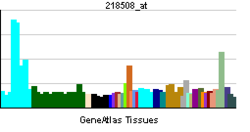- DCP1A
-
mRNA-decapping enzyme 1A is a protein that in humans is encoded by the DCP1A gene.[1]
Decapping is a key step in general and regulated mRNA decay. The protein encoded by this gene is a decapping enzyme. This protein and another decapping enzyme form a decapping complex, which interacts with the nonsense-mediated decay factor hUpf1 and may be recruited to mRNAs containing premature termination codons. This protein also participates in the TGF-beta signaling pathway.[1]
Interactions
DCP1A has been shown to interact with DCP2[2] and UPF1.[2]
References
- ^ a b "Entrez Gene: DCP1A DCP1 decapping enzyme homolog A (S. cerevisiae)". http://www.ncbi.nlm.nih.gov/sites/entrez?Db=gene&Cmd=ShowDetailView&TermToSearch=55802.
- ^ a b Lykke-Andersen, Jens (Dec. 2002). "Identification of a human decapping complex associated with hUpf proteins in nonsense-mediated decay". Mol. Cell. Biol. (United States) 22 (23): 8114–21. doi:10.1128/MCB.22.23.8114-8121.2002. ISSN 0270-7306. PMC 134073. PMID 12417715. http://www.pubmedcentral.nih.gov/articlerender.fcgi?tool=pmcentrez&artid=134073.
Further reading
- Bai RY, Koester C, Ouyang T, et al. (2002). "SMIF, a Smad4-interacting protein that functions as a co-activator in TGFbeta signalling.". Nat. Cell Biol. 4 (3): 181–90. doi:10.1038/ncb753. PMID 11836524.
- Callebaut I (2002). "An EVH1/WH1 domain as a key actor in TGFbeta signalling.". FEBS Lett. 519 (1-3): 178–80. doi:10.1016/S0014-5793(02)02751-5. PMID 12023040.
- Lykke-Andersen J (2003). "Identification of a human decapping complex associated with hUpf proteins in nonsense-mediated decay.". Mol. Cell. Biol. 22 (23): 8114–21. doi:10.1128/MCB.22.23.8114-8121.2002. PMC 134073. PMID 12417715. http://www.pubmedcentral.nih.gov/articlerender.fcgi?tool=pmcentrez&artid=134073.
- Strausberg RL, Feingold EA, Grouse LH, et al. (2003). "Generation and initial analysis of more than 15,000 full-length human and mouse cDNA sequences.". Proc. Natl. Acad. Sci. U.S.A. 99 (26): 16899–903. doi:10.1073/pnas.242603899. PMC 139241. PMID 12477932. http://www.pubmedcentral.nih.gov/articlerender.fcgi?tool=pmcentrez&artid=139241.
- Ingelfinger D, Arndt-Jovin DJ, Lührmann R, Achsel T (2003). "The human LSm1-7 proteins colocalize with the mRNA-degrading enzymes Dcp1/2 and Xrnl in distinct cytoplasmic foci.". RNA 8 (12): 1489–501. PMC 1370355. PMID 12515382. http://www.pubmedcentral.nih.gov/articlerender.fcgi?tool=pmcentrez&artid=1370355.
- Leonard D, Ajuh P, Lamond AI, Legerski RJ (2003). "hLodestar/HuF2 interacts with CDC5L and is involved in pre-mRNA splicing.". Biochem. Biophys. Res. Commun. 308 (4): 793–801. doi:10.1016/S0006-291X(03)01486-4. PMID 12927788.
- Ota T, Suzuki Y, Nishikawa T, et al. (2004). "Complete sequencing and characterization of 21,243 full-length human cDNAs.". Nat. Genet. 36 (1): 40–5. doi:10.1038/ng1285. PMID 14702039.
- Lehner B, Sanderson CM (2004). "A protein interaction framework for human mRNA degradation.". Genome Res. 14 (7): 1315–23. doi:10.1101/gr.2122004. PMC 442147. PMID 15231747. http://www.pubmedcentral.nih.gov/articlerender.fcgi?tool=pmcentrez&artid=442147.
- Beausoleil SA, Jedrychowski M, Schwartz D, et al. (2004). "Large-scale characterization of HeLa cell nuclear phosphoproteins.". Proc. Natl. Acad. Sci. U.S.A. 101 (33): 12130–5. doi:10.1073/pnas.0404720101. PMC 514446. PMID 15302935. http://www.pubmedcentral.nih.gov/articlerender.fcgi?tool=pmcentrez&artid=514446.
- Gerhard DS, Wagner L, Feingold EA, et al. (2004). "The status, quality, and expansion of the NIH full-length cDNA project: the Mammalian Gene Collection (MGC).". Genome Res. 14 (10B): 2121–7. doi:10.1101/gr.2596504. PMC 528928. PMID 15489334. http://www.pubmedcentral.nih.gov/articlerender.fcgi?tool=pmcentrez&artid=528928.
- Liu J, Valencia-Sanchez MA, Hannon GJ, Parker R (2005). "MicroRNA-dependent localization of targeted mRNAs to mammalian P-bodies.". Nat. Cell Biol. 7 (7): 719–23. doi:10.1038/ncb1274. PMC 1855297. PMID 15937477. http://www.pubmedcentral.nih.gov/articlerender.fcgi?tool=pmcentrez&artid=1855297.
- Rual JF, Venkatesan K, Hao T, et al. (2005). "Towards a proteome-scale map of the human protein-protein interaction network.". Nature 437 (7062): 1173–8. doi:10.1038/nature04209. PMID 16189514.
- Fenger-Grøn M, Fillman C, Norrild B, Lykke-Andersen J (2006). "Multiple processing body factors and the ARE binding protein TTP activate mRNA decapping.". Mol. Cell 20 (6): 905–15. doi:10.1016/j.molcel.2005.10.031. PMID 16364915.
- Olsen JV, Blagoev B, Gnad F, et al. (2006). "Global, in vivo, and site-specific phosphorylation dynamics in signaling networks.". Cell 127 (3): 635–48. doi:10.1016/j.cell.2006.09.026. PMID 17081983.
Nuclear Precursor mRNA · 5' cap formation · Polyadenylation (CPSF, CstF, PAP, PAB2, CFI, CFII) · Poly(A)-binding protein
RNA splicing: intron/exon · snRNP · spliceosome (minor spliceosome, U1) · alternative splicing · pre-mRNA processing factor (PLRG1, PRPF3, PRPF4, PRPF4B, PRPF6, PRPF8, PRPF18, PRPF19, PRPF31, PRPF38A, PRPF38B, PRPF39, PRPF40A, PRPF40B)
RNA editing · PolyuridylationCytosolic see also disorders of transcription and post transcriptional modification
B bsyn: dna (repl, cycl, reco, repr) · tscr (fact, tcrg, nucl, rnat, rept, ptts) · tltn (risu, pttl, nexn) · dnab, rnab/runp · stru (domn, 1°, 2°, 3°, 4°)Categories:- Human proteins
- Chromosome 3 gene stubs
Wikimedia Foundation. 2010.

